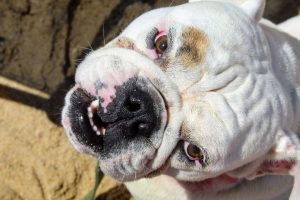Can you recall the last time you saw an English bulldog with a cherry-like eye that was bright red and swollen? As adorable as it may look, cherry eye is a severe medical problem, not a fashion statement.
Although it also affects other breeds, bulldogs are particularly susceptible because of their distinct structure and genetic makeup. This post will discuss:
- the symptoms,
- causes,
- diagnosis,
- treatment,
- and implications for bulldog owners of cherry eye.
I. What contributes to English bulldogs’ cherry eyes?
Imagine the face of an English bulldog as a little automobile with large headlights. Because to their small eye sockets and wrinkled skin, which make them vulnerable to infections and inflammations, those headlights, or eyes, are highly exposed. That is why you should always pay additional attention on properly cleaning Bulldogs wrinkles and preventing the infections!
In addition, a bulldog’s third eyelid, which includes a tear gland in charge of moisturizing the eye, is prolapsed or everted, which means it doesn’t retract correctly and can be exposed to outside irritants. The resultant swelling, redness, and infection of the gland can lead to an obvious cherry-shaped protrusion in the corner of the eye.
In addition, certain bulldogs may be genetically predisposed to cherry eye because their connective tissue is less robust and hence unable to retain the gland in place. Trauma, stress, allergies, or immunological problems can all be additional causes of cherry eye. The cherry eye, though, typically has an anatomical origin.
II. How may English bulldogs with cherry eye be identified and treated?
Take your bulldog to the doctor for a checkup and diagnostic testing if you think they may have cherry eye. The veterinarian will normally undertake a physical exam and check for indicators of cherry eye, including as redness, swelling, discharge, and exposure of the gland.
Also, they could use eye drops to check the gland’s functionality and perform imaging or blood testing if they think there might be an underlying issue. The veterinarian will advise either conservative care or surgical surgery based on the severity and length of the cherry eye.
For conservative care, the gland is encouraged to retract by employing
- eye drops, massage,
- warm compresses,
- and medicines to minimize infection and inflammation.

Depending on the form and location of the prolapse as well as the dog’s overall health, surgical surgery may entail the replacement, tacking, or removal of glands. The only effective option to treat severe or recurring cherry eye is frequently surgery, despite the fact that it may be more intrusive and expensive than conservative care.
III. How does cherry eye affect owners of English bulldogs?
In addition to being an aesthetic concern, cherry eye is also a health issue that, if left untreated, can result in discomfort, suffering, and even vision loss. Bulldog owners must thus be aware of cherry eye symptoms and seek early medical assistance if they experience any.
Ignoring cherry eye can result in more involved and expensive treatments, including as recurrent surgeries, prescription drugs, or even eye removal, which can negatively affect the dog’s quality of life and well-being. It can also cause other health problems in bulldogs, and we want to prevent that from happening!
Moreover, cherry eye may be a symptom of underlying medical conditions that require attention, such as allergies, infections, or immunological problems.
In addition, bulldog owners may need to make changes to their lifestyle, such as avoiding intense activities or donning a cone, as well as regular vet appointments, medication delivery, postoperative care, and lifestyle adaptations.
Because of this, it’s critical for bulldog owners to become knowledgeable about cherry eye and how to treat it. They also need to give their dogs a nurturing, sympathetic atmosphere that promotes healing.
Can Bulldogs live with cherry eye?
Bulldogs may survive with cherry eye, but treatment should begin very away to avoid problems and enhance the dog’s quality of life. If left untreated, cherry eye can result in pain, itchiness, infection, and visual impairment. It can also be an indication of other health problems that require care.
Thus, bulldog owners should seek guidance from a veterinarian if they believe their dog has cherry eye and heed their recommendations regarding the best course of action, which may include surgery, medication, or other types of therapy. Bulldogs with cherry eyes can have happy, healthy lives if they receive the right care and treatment.
Can cherry eye be treated at home?
Cherry eye is a medical disease that has to be treated by a specialist and is not something that should be done at home. The third eyelid gland prolapse, which in the majority of instances requires surgical repositioning or removal by a veterinarian, is the cause of cherry eye.
Making an attempt to cure cherry eye at home runs the risk of other issues, including damage, infection, or worsening of the ailment, and it can also prevent adequate care and healing. As a result, it’s crucial to seek veterinary assistance as soon as you believe your dog has cherry eye and to heed their recommendations for the best course of action.
According to the severity and underlying reasons of the problem, your veterinarian may advise a combination of surgery, medication, or other types of therapy. You can guarantee the greatest outcome for your dog’s health and wellbeing by obtaining professional assistance.

What happens if you don’t treat cherry eye?
Untreated cherry eye can result in a number of issues that can harm the affected dog’s health and way of life. Untreated cherry eye may have a number of negative effects, including:
- Inflammation: Dogs with cherry eye may experience pain and discomfort due to inflammation, redness, and swelling of the ocular tissue.
- Infection: Bacteria or other pathogens may invade the exposed third eyelid gland, causing more inflammation, discharge, and pain.
- Vision impairment: Dogs with cherry eye may have hazy or distorted vision, which can impede their mobility, safety, and quality of life. Cherry eye can also create obstruction to the dog’s eyesight.
- Corneal ulcers: If a dog rubs or scratches their eye because they are uncomfortable or irritated, they may develop corneal ulcers. These are unpleasant and, if ignored, may cause loss of eyesight.
- Chronic conditions: Cherry eye can become chronic if neglected for a long time, meaning the gland loses its ability to function and cannot be adequately treated with surgery or medicines.
Hence, it’s crucial to get expert assistance if you think your dog has cherry eye and to stick to the suggested treatment choices to avoid future issues and to encourage healing and recovery.

